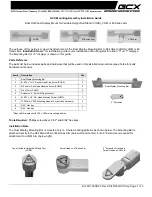
37
3. Standard TV-norm : divider ratio 525(60Hz) or 625(50Hz)
When the system is switched to the narrow window (standard mode) it is checked whether the incoming vertical
sync pulses are according to the TV norm, if so IVW=1, When 15 standard TV-norms are counted the divider
system is switched to the standard divider ratio mode. In this mode the divider is always reset at the standard
value even if the vertical sync pulse is missing.
The system switches back to the narrow window when 3 vertical sync pulses are missed. When also in the narrow
window 3 vertical sync pulses are missed the divider will switch to the search window mode.
As described above the vertical divider needs some waiting time before switching back to the search window mode.
When a fast reaction is required for instance during channel switching the system can be forced to the search win-
dow by means of I
2
C bus, setting NCIN=1 (vertical divider mode). Immediate after forcing to search mode NCIN has
to be set back to 0 for optimum performance.
The vertical synchronisation mode of operation can be selected by I
2
C bus FORF/S, forced field frequency.
Furthermore50/60Hz identification is available by I
2
C bus FSI(50/60Hz), and norm signal identification with IVW.
Interlace can be switched on and off by I
2
C bus DL.
Geometry (vertical & horizontal) and drive of vertical deflection
We can distinguish the following main blocks, which will be described in more detail below :
- Vertical sawtooth generator
- Vertical geometry processor
- Horizontal(E-W) geometry processor
- EHT tr overvoltage protection
• Vertical sawtooth generator
The vertical sawtooth generator delivers the reference signals for vertical and horizontal geometry processor.
An accurate reference current (Iref)of 100µA is realised by means of an internal bandgap reference voltage(3.9V)
and an external resistor (39k
Ω
). This 100µA reference current is used to derive a 16µA current to charge the exter-
nal capacitor during vertical scan. This circuitry ensures a very linear sawtooth(Usaw) that is used for further pro-
cessing on vertical and horizontal(E-W).
The charge current for the sawtooth is automatically adapted for 50/60Hz via control bit FSI. Furthermore the
charge current can be adjusted with the I
2
C bus control, VS(vertical slope). The range of +/– 20% should be used to
compensate for tolerance of the extrnal capacitor. When vertical zoom is applies, VS. can be used to vary the posi-
tion of the bottom part of the picture independent from the upper part (subtitle shift)
The external capacitor is discharged during vertical retrace by the vertical divider system.
• Vertical geometry processor
The sawtooth signal that is derived from the sawtooth generator can be controlled by I2C bus. Control functions are
: VA(Vertical Amplitude, VSH(Vertical Shift), SC(S-Correction), VX(Vertical eXpand(zoom)), VSC(Vertical SCroll).
The vertical geometry processor has a differential current output for a DC coupled vertical output stage(drive).
It is important to notice that the TDA884X is designed for use with a DC coupled output stage. This is the reason
why a vertical linearity alignment is not necessary (and therefore not available).
A half picture blanking function (service blanking, SBL) is available for vertical alignment.
• Horizontal geometry processor(E-W drive) (Not in all versions)
The horizontal geometry signal for E-W drive can control via the I
2
C bus the following functions :
EW(EW-Width), PW(Parabola/Width), CP(Corner/Parabola) and TC(Trapezium Correction).
The EW-width adjust range is such that linear zoom is possible on the picture size when used together
with vertical expand (zoom).
The horizontal geometry processor has a single-ended current output for E-W drive.
Summary of Contents for DTR-14D3VG
Page 5: ...3 Circuit Block Diagram...
Page 10: ...8 3 Block Diagram...
Page 66: ...64 1 14D3 Mechanical Exploded View...
Page 67: ...65 2 20D3...
Page 68: ...66 3 21D3...
Page 69: ...67 4 16D3...
Page 70: ...67 Printed Circuit Boards...
Page 71: ...Circuit Schematics CP 490 SCHEMATIC DIAGRAM...
Page 72: ...ENGINEER NOTE...
















































